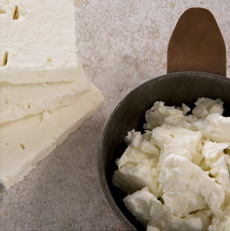TIP OF THE DAY: Make A Small Greek Salad
|
|
Some people love a luncheon size Greek salad. But how about as your first course?
Now that beautiful tomatoes are in season, slice them up in as many ways as you can, including in a first course Greek salad. In Greece, what we call a “Greek salad” (more about that below) is served with every meal. So today’s tip is: Enjoy a Greek salad at home, regularly. When you make your own, you can add as much feta, olives, pepperoncini and other favorite ingredients as you like. Making your own lets you build a better salad in these ways, too: |
|
|
You can also add the ingredients common in Greece: anchovies, bell pepper, capers and sardines, to the conventional American mix of cucumber, red onion, kalamata olives, pepperoncini, feta cheese and lettuce. Serve your Greek salad as a main meal, a smaller salad course, or as a soup-and-salad or sandwich-and-salad combo for lunch. Here’s the Greek salad recipe, including the traditional red wine vinaigrette. Food Trivia: In Greece, the feta-cucumber-onion-and-more salad is referred to as horiatiki, which translates to country/village/peasant salad. It is a common part of a traditional Greek meal, just as a lettuce and tomato salad was once a standard on the American dinner table. Horiatiki doesn’t contain lettuce—that’s an American preference. In Greece, you’ll only see lettuce used at restaurants that cater to tourists. An authentic horiatiki is a combination of all or some of the following: anchovies, bell pepper, capers, cucumber, feta cheese, Kalamata olives, onion, sardines and tomato. It is dressed with olive oil only—no vinegar—plus oregano, salt and pepper. |
||
|
TREAT YOURSELF TO QUALITY FETA CHEESE
Feta is one cheese where bargains should be avoided. Less expensive feta is often over-salted to the point of unpleasantness. Some knock-off feta is dry and rubbery, with none of the crumbliness of the original. Feta, made from sheep’s milk or a blend of sheep’s and goat’s milks, is dry-salted and aged in wood barrels. There they sit in a brine solution that was originally devised so farmers could preserve their product in the hot Mediterranean climate. The brine gives feta its characteristic tang. A quality feta goes through a four-month maturation, developing a creamy, rich, complex flavor. According to Murray’s Cheese, only 2% of feta consumed in the U.S. actually hails from Greece. The economic collapse of Greece has put many traditional artisans out of business. |
|
|
|
Much of our feta is imported from Bulgaria, or are cheaper knock-offs made in the U.S. from cow’s milk. Unless you buy from a reputable cheesemonger, you don’t know what you’re getting. A quality feta should be briny, tang and crumbly. You deserve to experience the best! More Food Trivia: Feta been made at least since Homer’s time, the 8th century B.C.E.: He described it in The Odyssey. The word feta, meaning slice, came much later, in the 17th century. It likely refers to the slicing of cheese before it is placed in barrels to age. |
||




